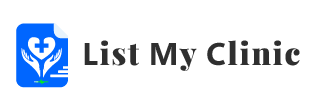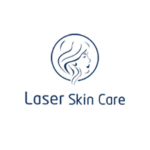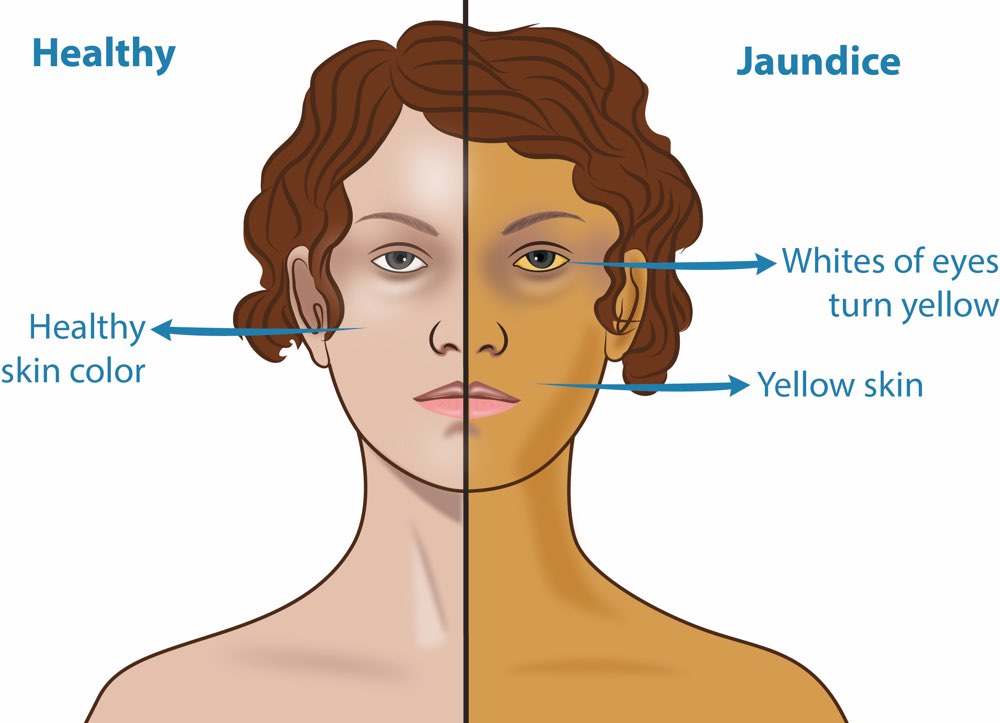
What are the Symptoms and Treatment of Jaundice?
In this article, we examine the symptoms and treatment of jaundice. But first, we need to discuss what jaundice is. The term jaundice stands for the change that occurs in the sclera (white membrane in our eye) turning yellow. It is caused due to the rapid increase in bilirubin, which is yellow-orange bile pigment. Bile is the fluid production in our liver. Bilirubin is also a waste material in our blood. In a report, it is confirmed that about 60 percent of newborn babies in the United States have jaundice. So, it is the major problem in the U.S.(United States).
As we know jaundice is related to the functioning process of the liver. So, we need to maintain our liver in some ways like eating a healthy diet, not drinking too much (or more than the recommendation), exercise regularly, and yoga (which helps our digestion and immune system in making better).
There are three types of jaundice based on their occurrence
Hepatocellular jaundice occurs due to injury or disease in the liver.
Hemolytic jaundice occurs due to sudden breakdown of RBCs or rise in bilirubin.
Any kind of obstruction in the bile duct causes this condition called jaundice.
There are two types of jaundice Based on patient age.
- Adult jaundice, in which the patient is an adult.
- Newborn jaundice, in which patient is newborn
Symptoms of Jaundice
Many studies show that people have jaundice but don’t show any of the symptoms related to jaundice. In this part of the article, we discuss all such cases regarding jaundice symptoms.
It is an accidental case when the person has jaundice but doesn’t show any of the symptoms of jaundice.
The Following are the symptoms related to jaundice in the human body.
The most common symptoms of jaundice include.
- Sudden change in our skin and eye’s white membrane (sclera) color to yellow, Pale stools, Urine goes dark, Itchiness produces in our skin
- Accompanying symptom of jaundice which is due to low bilirubin levels include Fatigue, pale stool, darkness in urine, fever, vomiting. Unfortunately, weight loss, pain production our abdominal
Now, we describe the symptoms as per the basis of infection, if a person is infected then the person shows symptoms such as fever, abdominal pain, itchiness, and flu-like symptoms. If the person isn’t infected then such symptoms occur like weight loss, itchy skin.
If the jaundice is caused by liver-related disease, inflammation occurs.
Here you study the symptoms from many factors after that we study how to treat jaundice? and how to diagnose jaundice?
Treatment of Jaundice
After we discuss, what is the treatment of Jaundice ? We need to know, how is it diagnosed?
The doctor used to check liver disease signs like spider angiomas (collection of a blood vessel near the skin, Palmar erythema (palm and fingertip get on reddish), skin’s brushing.
Thereafter, doctors use urine test, CT scan, and ultrasonography to diagnose the jaundice
In adult persons, jaundice can be cured, by our immune system. If your body has acute viral hepatitis and jaundice cured itself, and your liver heals itself. But if you have an extremely high bilirubin level then it may be a problematic situation for you, because now it uses the treatment of jaundice.
In a new one, it cannot be cured itself; they need good treatment for curing jaundice. Generally, jaundice takes one or two weeks to cure, but in newborns, this may take more time. If your baby is prematurely (born) then it cures itself, but other tests are needed.
Here we provide you information to get treatment of jaundice in newborns.
Provide nutrition (cause of weight loss newborn need some supplement nutrition for growth and immune system), light therapy(in this process newborn is preserved under the light, a special kind of light not sunlight, by which photo-oxidation adds oxygen to bilirubin so, it easily dissolve in the water), Intravenous immunoglobulin (IVIg)(used for a variety of indications in the newborn period, such as alloimmune neonatal thrombocytopenia and adjunctive treatment of neonatal infections), Exchange transfusion(this is the vital process of heredity, and it does by exchanging the blood antibodies from his parents). With these steps, you can get rid of the jaundice problem.
If your liver got a severe problem, jaundice may be accomplished by a serious problem, such as failure of brain function and a tendency to bleed or bruise. Acute viral hepatitis is also a cause of jaundice, generally in young, and otherwise healthy people.
Additional information
I think the above-mentioned help you to understand the jaundice symptoms and treatments. But last one thing, I want to substitute, adult jaundice can cure itself, but sometimes when your bile duct gets blocked this is a serious problem, you need to take advice from doctors. One more thing, want to add for newborn jaundice is a serious problem, but it also a reason for rare brain disease
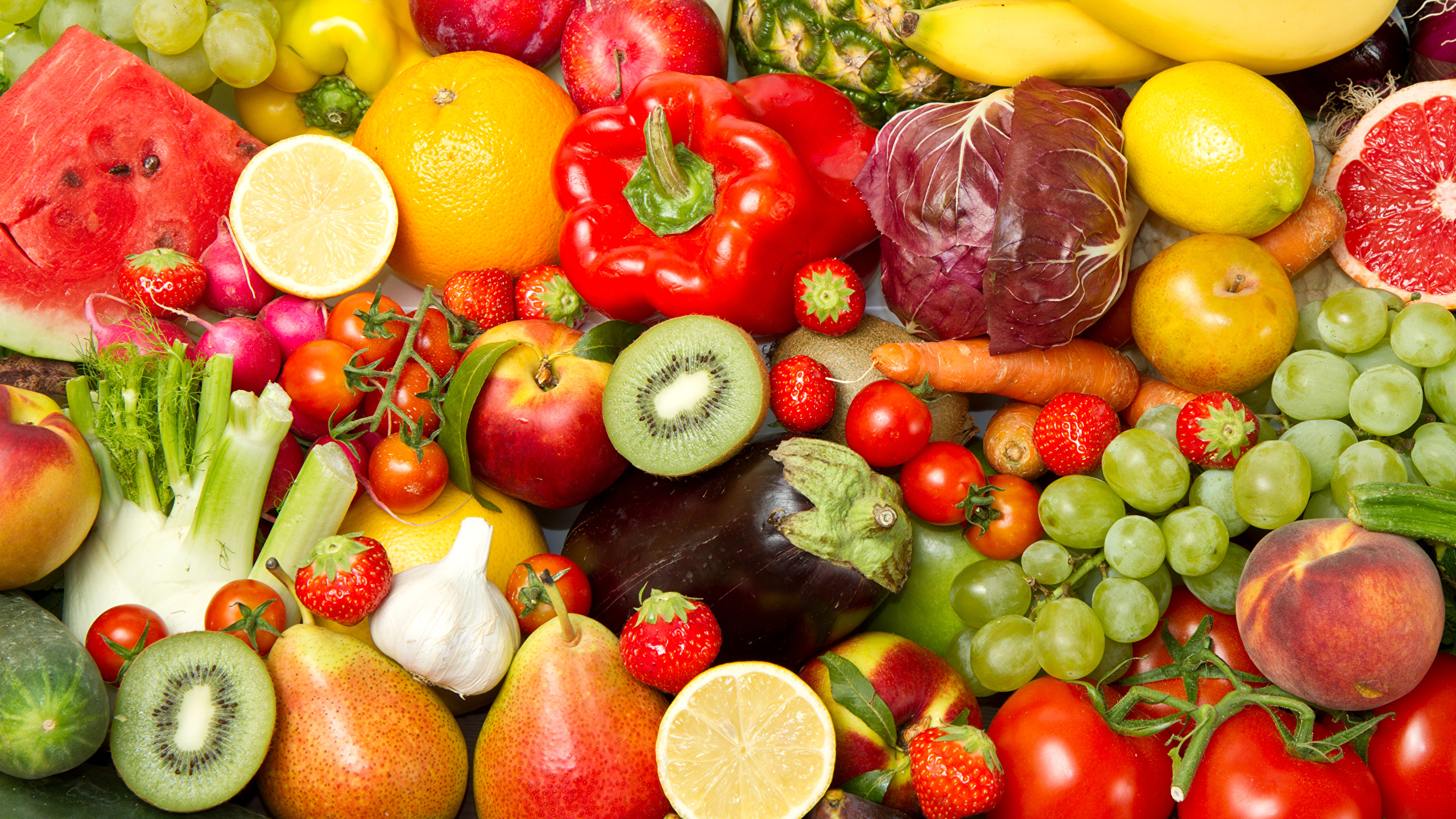
8 Best Fruits That Are Good for Controlling Diabetes
Diabetes is a group of diseases that result in too much sugar in the blood(high blood glucose). a person having these diseases called diabetics. The main cause of diabetes is
1. Pancreas not producing enough insulin to the body
2. The cells of the body not responding properly to the insulin produced by the body.
There are the 8 most common fruits that controlling diabetes are:-
1. Apples
Polyphenols are found in the skin of Apple which is helpful to improve the body’s ability to utilize insulin effectively. This helps your cells absorb sugar and provide energy and regularly eating apples may reduce insulin resistance, leading to lower blood sugar levels.
A medium-sized apple contains 0.3 grams of fat, 95 calories, 4.4 grams of fiber, 0.4 grams of proteins, 25 grams of carbs. And also it is a good source of vitamins, apple provides 14% of your daily recommended vitamin c intake. It is cholesterol-free, fat-free, and sodium-free. Apples having a low glycemic index(GI) and glycemic load(GL) of about 32 and 4.7 respectively. which causes a minimal rise in blood sugar levels that’s why Apple is one of the best diabetes-friendly fruit.
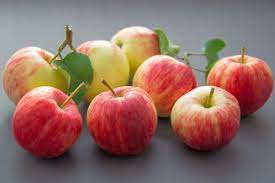
2. Bananas
Bananas having much potassium. a medium-sized banana contains 9% of the RDI. Banana can help lower blood pressure. Banana has a low glycemic index(GI) . A medium-sized banana contains 1mg of, having 0 cholesterol. It is low in calories having 105 calories. It also contains 422 milligrams of potassium, 3.1 grams of fiber, and It contains fiber which helps to slow the digestion of carbohydrates and plays an important role in maintaining a normal gut environment, metabolism, and decreasing cholesterol. That’s why the banana plays important role in controlling diabetes.

3. Pears
Red-skinned pears have carotenoids which reduce the danger of cancer and eye disease. Antioxidants, vitamins, and minerals are found in pears. Pears contain a low glycemic index(GI) and glycemic load(GL) of approx 30 and 7 respectively. A medium-sized pear having. It contains 101 calories, 27 grams of carbohydrates, 5.5 grams of fiber where 71% is insoluble and the remaining is soluble, 206 mg of potassium, 7.5 grams of vitamin C. Pears have many health benefits because it is rich in vitamin and nutrient.it has fighting inflammation, serving as an antihyperglycemic and it is helping with digestion. so that pears are helpful for diabetics.
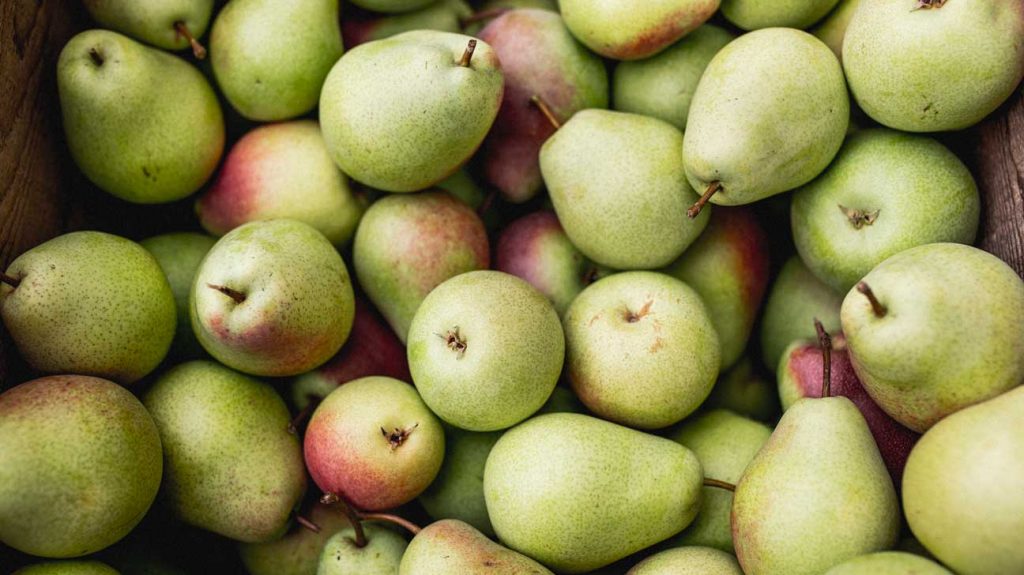
4. Grapes
A study is held by the British Medical Journal in 2013 and found that grapes are helpful with a lower risk of developing type 2 diabetes. Grapes having some important nutrients and powerful plant compounds which is helpful for health. Grapes have a low glycemic index (GI)59 and do not raise blood sugar levels and they contain sugar.
.One cup (151 grams) of grapes having they contain 104 calories, 27.3 grams of carbs, 1.1 grams of protein, 0.2 grams of fat, 1.4 grams of fiber, 27% of the vitamin C of RDI, 8% of the potassium of the RDI.Grapes have also vitamin C, beta carotene, quercetin, lutein, and ellagic acid which are powerful antioxidants. These qualities of grapes help diabetics to recover from diabetes.

5. Oranges
The cultivation of oranges has started in eastern Asia thousands of years ago. Oranges are one of the most popular fruit. they are also called sweet oranges. Oranges are a good source of fiber, vitamins, thiamine, folate, and antioxidants. They have many more benefits of health. A medium-sized orange(100 grams)contains 47 calories, 87% of water, 0.9 grams of protein, 9.4 grams of sugar, 11.8 grams of carbs, 2.4 grams of fiber, 0.1 grams of fat. Regular consumption of oranges is beneficial for health. they have a low glycemic index so they less affect blood sugar and insulin levels. Diabetics can eat one navel orange per day is beneficial for their health.

6. Berries
According to the ADA (American Diabetes Association) berries are beneficial for diabetics whether they like blueberries, strawberries, or any other type of berry all are helpful because they are full of antioxidants and fiber. Berries may benefit blood sugar management by increasing insulin sensitivity and improving clearance from the blood. One cup of fresh blueberries contains 84 calories, 21 grams of carbohydrates, 4 grams of fiber, 11 grams of carbohydrates, 0 grams of fat. The Glycemic index measure in berries is 53, which is low GI. This is the same as a banana. The glycemic load of berries is low which includes portion size and digestible carbohydrates. One cup of blueberries (150 g) has a GL of 9.6.

7. Kiwi
Kiwi is beneficial for both types of diabetes whether you have Type1 or Type 2 diabetes.it is one of the best fruits for people suffering from diabetes.it controls your blood sugar level and also helps in controlling diabetes because it is rich in vitamin C.it increases the immunity and ability to fight the diseases. One kiwi contains many nutrients that it contains 42 calories, 10 grams of carbohydrates, 215 my of potassium, 64 mg of vitamin C, 2 grams of fiber. Kiwi has a low glycemic index of 50 as well as a low glycemic load of 7.7. This makes it a healthy choice amongst the list of fruits. An average person can eat around 2-3 kiwis per day.
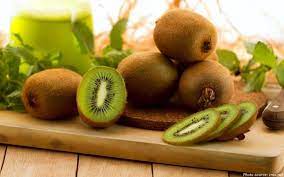
8. Avocados
It is a creamy green fruit that is full of vitamins, nutrients, and heart-healthy fats. Avocados are helpful for type 2 diabetes patients, mentioning them in your diet may help to lose weight, lower cholesterol and increase insulin sensitivity. It is rich in fiber. The minimum intake of fiber for people with type 2 diabetes is around 40 grams. Avocado is cholesterol-free, gluten-free, low in sodium and it contains, 227 calories, 2.7 grams of protein, 12 grams of carbs, 21 grams of fats, 9.2 grams of fiber. It provides a healthy dose of monounsaturated fats, which may help lower bad cholesterol. so that it takes an important role in controlling diabetes.
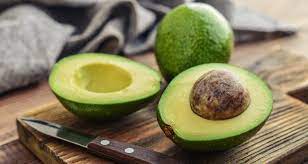
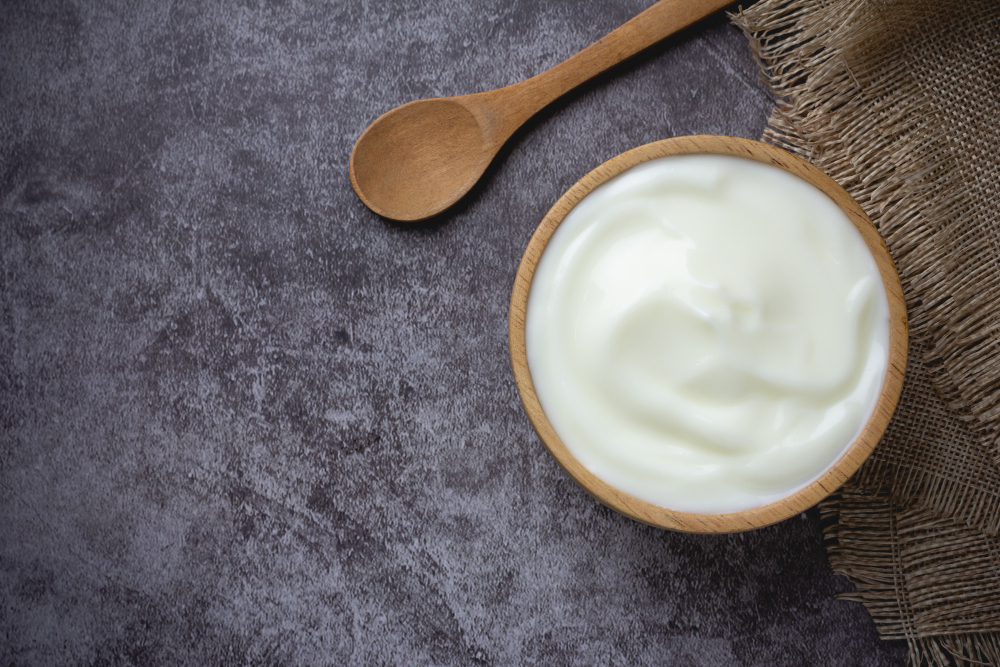
7 Health Benefits of Yogurt For a
Healthy Body
You may be wondering what the health benefits of yogurt are. The good news is that you may be surprised to find out that this dairy product contains several essential nutrients, including calcium, protein, and healthy fats. But before you go out and purchase a jar of yogurt, let’s look at what you can expect from it. You’ll also discover how you can maximize its benefits for your body by adding it to your diet regularly.
There are several reasons why eating yogurt can be beneficial for erectile dysfunction. In addition to its sour taste, yogurt is packed with nutrients that improve your health and increase your libido. This healthy diet is also recommended by many physicians and scientists. However, some people have concerns about yogurt for erectile dysfunction.
Make an appointment with your doctor for tests to rule out an underlying medical cause. There are a number of effective treatments including Cenforce 150 (Sildenafil Citrate), tadalafil, vardenafil to improve ED.
Protein
Eating high-quality yogurt can improve your diet. The high protein and healthy fat content of Greek yogurt can help you feel fuller for longer. Regular consumption of this food has been associated with lower body weight, lower body fat, and a smaller waist circumference. In addition to reducing hunger, yogurt has been linked to a reduced risk of Type 2 diabetes. It is an excellent source of protein and low in calories.
While yogurt is generally a healthy food, there are some people who would prefer something different as a snack or for breakfast. For instance, milk-based yogurt is not suitable for those with dairy allergies, while those who are lactose-intolerant should go for plant-based varieties. This is not to say that people with milk allergies should not consume yogurt, but they should be careful to select yogurt that does not contain dairy.
The probiotics in yogurt have several benefits for your health. First, it aids digestion. It contains bacteria that encourage healthy immune cells in your body, thereby reducing the likelihood of bloating or gas. Another benefit of eating yogurt is that it is highly digestible, which means that regular consumption can prevent embarrassing situations. In addition to promoting a healthy body, it can also help you fight off infection and colds.
Calcium
Milk is one of the best sources of calcium, but it can be high in fat and calories. Likewise, calcium can also be found in some leafy green vegetables and canned salmon. If dairy products aren’t your thing, you can also get calcium from fortified juices. Soy products and rice beverages also contain calcium. While calcium absorption rates may vary, these sources are good for your body. So, while milk and yogurt contain a high concentration of calcium, they may not be the best choice for everyone.
Plant foods contain oxalates, a substance that binds to calcium. To ensure your body absorbs calcium, you need to eat it in a form your body can use. This is known as bioavailable calcium. A good source of calcium is yogurt, but you can also eat almonds, sesame seeds, baked beans, kidney beans, pinto beans, and firm tofu.
Vitamins
Yogurt is a great source of vitamins and minerals, and it can easily fill up the star of any meal. The vitamin B12 in yogurt helps support the formation of red blood cells, nerves, and genetic material. It also prevents anemia, a disorder that makes people weak and tired. A cup of plain low-fat yogurt contains around half of the daily recommended allowance for vitamin B12.
Milk and yogurt are particularly rich in vitamin D, which is important for the growth and development of strong bones. It also helps maintain a healthy blood pressure level. Older people should consider eating more yogurt as it can help boost their bone-mineral density. In addition, studies show that yogurt eaters have lower blood pressure than non-consumers. This may be due to the fact that milk and yogurt consumption have an inverse relationship with blood pressure.
While saturated fat is associated with heart disease, there are a variety of sources of this vitamin. Low-fat and fat-free yogurt are becoming increasingly popular in the United States, but they still contain a small amount of saturated fat. Full-fat dairy products don’t contain the same amounts of saturated fat as highly processed fast food. And while saturated fat in yogurt isn’t directly related to heart disease, it is beneficial for your overall health.
Healthy fats
Adding yogurt with healthy fats to your diet is an easy way to improve your health. You can easily replace low-fat yogurt with full-fat yogurt by using additional healthy ingredients, like nuts, seeds, and olive oil. These are also great ways to boost your nutrition. And if you want to go even further, you can also incorporate yogurt with healthy fats into your salad dressings or smoothies.
It’s easy to mistake saturated and trans fats for unhealthy fats. But the truth is that they are not the same thing. While both can raise your cholesterol levels, the good kind is essential for brain function and satiety. But, there are some unhealthy fats you need to avoid. According to nutritionist Brianna Elliott in St. Paul, Minnesota, saturated fat is linked to increased LDL (bad cholesterol) and is the main source of fat in many processed foods.
High-quality, full-fat yogurt is loaded with beneficial probiotic bacteria. It can help improve your digestive health and fight obesity and heart disease. Yogurt also contains healthy fats like linoleic acid and vaccenic acid. Yogurt may contain more of these beneficial fats than milk. It also contains lactose, which is broken down by bacteria. The fat content in plain yogurt is around five percent.
Digestive health
While the FDA allows additives such as sweeteners and flavorings to commercial yogurt, this food is still packed with beneficial bacteria. Traditional yogurt contains two kinds of live microorganisms: Lactobacillus acidophilus and Streptococcus rhamnosus. These microbes work with the bacteria in the gut to produce many of the benefits of yogurt. In addition to their probiotic and antimicrobial properties, yogurt provides your body with calcium, vitamin D, and a variety of other minerals.
Yogurt is loaded with probiotics, live bacteria that keep your digestive system in good shape. These bacteria help keep your digestive tract functioning well and prevent a range of illnesses. Antibiotics can wipe out good bacteria in the gut. Increasing the amount of probiotics in your diet is a great way to restore that vitality. Probiotics are a vital part of the human body, and yogurt is a great choice for people who are lactose intolerant.
There are many types of yogurt, and not all are created equal. Some contain artificial sweeteners that are less healthy than real sugar and set your taste buds on a junk food escalating cycle. So make sure to read labels carefully to find the yogurt with the highest concentration of probiotics and avoid those with artificial ingredients. There are also many flavored yogurts on the market. You’ll want to choose the right one for you.
Bone health
If you’re looking for a cheap yet effective way to promote bone health, yogurt might be a great choice. This food is loaded with vitamin D, B vitamins, calcium, protein, and probiotics. Many types of yogurt are high in these nutrients. Other excellent sources of probiotics include kefir and cottage cheese. Choose plain yogurt and stay away from processed brands with added sugars and food dyes. You can also add fresh fruit and spices to your yogurt to enhance its health benefits.
A recent study tracked the intake of 4,310 Irish adults. Researchers assessed bone mineral density and physical function of participants to determine their yogurt consumption. Yogurt eaters showed higher BMD in the hip and femoral neck than those who did not eat yogurt. High yogurt eaters also had higher vitamin D levels and lower Trap 5b, a marker of osteoclasts. The results of this study are encouraging.
Heart health
Increasing consumption of yogurt is linked to heart health benefits, but it is not the only benefit of this dairy product. Aside from reducing the risk of heart disease, it is also high in protein, which is essential for the growth of strong bones, teeth, and muscles. A cup of yogurt contains nine to fourteen grams of protein, which is an excellent source of calcium. It can also help curb your appetite and tide you over until your next meal.
A new study conducted by researchers at Harvard Medical School and the Boston University School of Medicine has demonstrated a correlation between the consumption of yogurt and a reduced risk of cardiovascular disease. The study looked at the health records of over 740,000 people with high blood pressure, and then measured the amount of yogurt they consumed each day, and weighted that against their heart-related diagnoses. The results showed that a higher daily yogurt intake decreased the risk of heart attack in women by more than 30%, while the same reduction occurred in men. Both men and women experienced a 20 percent reduction in their risk of major coronary heart disease.
Diabetes prevention
Studies have shown that unsweetened plain yogurt is beneficial for people with diabetes. The probiotics and low-carb content of yogurt make it an ideal choice for people with diabetes. While the recommended amount of dairy products is three servings a day for adults, this recommendation is controversial among health experts. When shopping for yogurt, look for a brand with active cultures and fewer than 10 grams of sugar. Yogurt is also an excellent source of protein and calcium and can be eaten for a variety of health benefits.
One study suggests that probiotics in yogurt can protect against Type 2 diabetes by regulating the microbiota in the digestive tract. The lactic acid bacteria in yogurt may help regulate the glycemic index, reducing the dramatic swings in blood sugar levels. Additionally, yogurt contains nearly every essential nutrient you need to stay healthy. It is high in calcium and contains a variety of B vitamins. High-fiber yogurts can protect against health defects caused by vitamin B12. It also contains magnesium and potassium, two of the most important nutrients for your metabolism and blood pressure.

Pregnancy: Sign, Symptoms, Overview & Health Tips you need to follow
Overview
During ovulation, the sperm fertilizes an egg after releasing it from the ovary. Then the fertilized egg travels down into the ovary and implantation occurs. As a result of successful implantation is pregnancy.
A full-term pregnancy is about 40 weeks. you should keep in your mind that many factors can affect the pregnancy so that women should receive an early pregnancy diagnosis and parental care. If pregnant women follow regularly important health tips during pregnancy will likely experience a healthy pregnancy and give birth to a healthy baby. all the pregnancy information is important for your health and also for your baby’s health. There are many ways to prevent pregnancy and effective birth control.
The most common early signs and symptoms of pregnancy are :
Sporting and cramping

When the sperm travels through the vagina, into the uterus, and formed an egg found in the fallopian tube. at this time fertilized egg attaches itself to the wall of the uterus. this sign begins anywhere from 6 to 12 days after the egg is fertilized this is called implantation bleeding.
Breast Changes
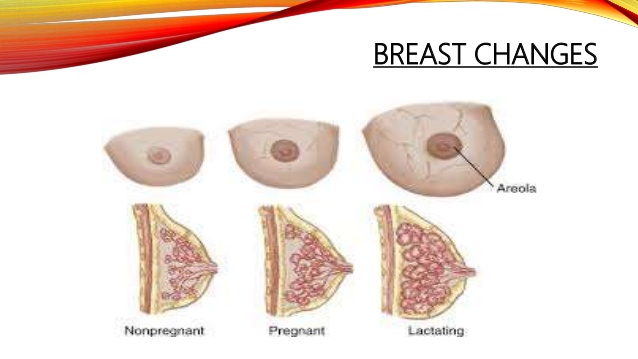
After conception, the level of the hormone of women changes rapidly. Because of these changes their breast becomes swollen sore.it occurs 1 or 2 weak later after conception. the area around the nipples called areola might darken. If these changes occur due to pregnancy it might take several weeks to get a new level of hormones. once a new level of hormones comes then there is ease up in the breast pain.
Fatigue

It is very normal to feel tired during pregnancy. if women feeling tired due to pregnancy so they must eat food that is rich in protein and iron.it can help to offset it. It is related to a high level of a hormone called progesterone also other things like lower levels of blood sugar, lower blood pressure, and a boost in blood production.
Nausea(morning sickness)

Nausea during pregnancy may occur at any time but mostly it seems that it occurs in the morning.it is a very famous or common sign of pregnancy but this is not necessary to get every pregnant woman. This is also related to hormonal changes because every woman does not eat proper food which is eaten by pregnant women for their health and also for their baby’s health.
Missed Period

The instant pregnancy test for women is missed period. It is the most evident sign of pregnancy but not every time it is not every time delayed due to pregnancy and also there are many more reasons for a missing period like you gained or lost too much weight, fatigue, and stress, or many more other possibilities. They missed a period when they stop taking birth control pills. But if the period is missing you should get to the pregnancy test.
Symptoms during pregnancy
Moodiness
This is also a common symptom during pregnancy because of the overflow of hormones in your body in early pregnancy that can make you unusually emotional and weepy.
Bloating
During early pregnancy there is hormonal changes occur that can cause you to feel bloated, similarly that you fell at the starting of your menstrual period.
Light spotting
When the fertilized egg attaches to the wall of the uterus about 10 to 14 days after conception and bleeding is occurs which is known as implantation bleeding. It takes place at the time of the menstrual period but it is not necessary for all women. sometimes it is the first sign of pregnancy.
Constipation
Constipation is an infrequent bowel movement, small, hard to pass, stool. and its examples are dehydration, lack of dietary fiber and physical inactivity, etc. it is also due to hormonal changes that cause the digestive system to slow down, which lead to constipation.
Nasal congestion
During pregnancy, there is an increase in hormone levels and blood production which is causing the mucous membrane in your nose to swell, dry out and bleed easily. This causes a runny nose.
Above there is some common sign and symptoms during pregnancy but there is much more significant and symptoms which are seen during pregnancy some of them are Heartburn, food aversion, diarrhea, vomiting, frequent urination, raised temperature, dizziness, headache and many more.
Some health tips that need to follow by pregnant women
Eating is most important during pregnancy, they should eat some healthy and nutritious food for their health and also for their good delivery experience.
During pregnancy, your body shape is rapidly changing so for a good experience you should wear tight clothes that can suffocate you and your body.
Pregnant women should have talked to their baby who cuddled in your womb. It should be good for your mental health and these are memorable and soul-soothing activities.
Pregnant women should necessarily exercise regularly because during pregnancy their body goes under several changes like shape and weight.
Drink more water to still dehydrated yourself drinking more water is beneficial for all but pregnant women should necessarily drink more water for their health
Signs of a Healthy Pregnancy
• Their Blood Sugar and Blood Pressure levels are normal
• Health of the Uterus and Placenta
• The development of the Foetus is normal
• weight gain of pregnant women
Pregnancy is one of the memorable periods for many women. In this time they should not take any stress only think about their baby and their health. For any type of query regarding their pregnancy, they should regularly contact their doctor.

Effective Ways for Blood Pressure Treatment
High blood pressure or hypertension is a dangerous disease because it can put you at risk for heart failure, kidney failure, stroke or other serious medical conditions. But the good thing is that the risks associated with high blood pressure can be greatly reduced by making certain modifications in your lifestyle as well as taking your medicines. Possibility of High Blood Pressure Treatment is something no one should ignore.
What is High Blood Pressure?
It is the force of blood pushing against the walls of arteries. When the pressure is consistently higher than the normal, then you are diagnosed with the condition called “Hypertension”
To make it simpler, let’s understand how it works:
The heart is an organ whose primary responsibility is to pump blood. The deoxygenated blood reaches the heart which is then oxygenated and delivered through the blood vessels to other organs of the body. Each heartbeat is the manifestation of this blood pumping process. When the heart beats, it creates pressure which pushes the blood throughout the vessels.
Blood Pressure is Created by Two Types of Forces:
Systolic pressure: It is the top number of the blood pressure reading which measures the pressure on the blood vessel walls when the heart contracts or as the blood pumps out of the body.
Diastolic Pressure: It is the bottom number of the blood pressure reading which measures the blood pressure when the heart rests between the beats.
Know your numbers!
If your blood pressure reading is 130/80 mm Hg, the systolic pressure is 130 mm Hg and diastolic pressure is 80 mm Hg.
Keeping this in mind, let’s understand the stages of hypertension:
Elevated: When the systolic level is between 120- 129 mm Hg and diastolic level is between 80- 89 mm Hg.
Hypertension stage 1: When the systolic level is between 130- 129 mm Hg and diastolic level is between 80- 89 mm Hg.
Hypertension stage 2: When the systolic level is between 140- 180 mm Hg and diastolic level is between 90- 120 mm Hg.
Hypertensive Crisis: When the systolic level is above 180 mm Hg and diastolic level is above 120 mm Hg.
Symptoms of High Blood Pressure
Most people with hypertension do not experience any symptoms which is why it is also called the “Silent Killer”. But a few people may have:
- Headache
- Nose bleeding
- Dizziness
- Heart palpitations
- Shortness of breath
- Vomiting
- Blurred vision
Treatment
Medications: The medications will depend upon how severe the hypertension is or whether there is risk of cardiovascular or other diseases. Your doctor may recommend one or combination of several different medicines which may change over time depending upon your condition. Therefore, you should work with a health care provider and only take prescribed medicines in the right dosages.
The hospitals that you can visit for the treatment of high bp :
- Ginihealth: Ginihealth is a new-age healthcare provider offering preventive and personalized healthcare services for various lifestyle disorders. They have a specialized “Blood Pressure Management” programme which is designed to bring the blood pressure to optimal levels with the help of medications, nutrition and exercise plans. Along with optimizing the blood pressure levels, the programme also aims at reducing other health complications and improving the overall health of patients.
- Fortis Heart & Vascular Institute: Fortis hospital has a highly specialized and co-ordinated team for the treatment and management of high blood pressure. They use a holistic approach towards hypertensive management which includes medications as well as lifestyle changes. They also provide 24- hour care for patients with critical conditions and heart problems.
- Paras Hospital, Gurgaon: Paras hospitals provide high-quality and compassionate care to their patients at affordable prices. They help patients control hypertension with medical treatment as well as guiding them about healthy eating and weight reduction, providing them remarkable possible outcomes.
Follow the Dash Diet
DASH diet, which stands for Dietary Approaches to Stop Hypertension, emphasizes on adding fruits, vegetables, whole grains, high-potassium foods, and low fat dairy products in your diet while reducing sodium intake. Patients are advised to cut back on salt, sugar, refined carbohydrates and processed food such as soda, juice, chips, canned soup etc and increase the intake of healthier foods like avocados, oranges, sweet potatoes, bananas etc. The idea of DAS diet is basically to replace a low carb, low fat diet with a high protein, high fiber diet.
Move Your Body
If you’ve been inactive for a long time it can increase your blood pressure. Therefore you should get regular exercise. For that, you don’t necessarily need to hit the gym but any activity that gets your heart pounding like cycling, swimming, playing a sport or even walking briskly can help you reduce your blood pressure. You can start out slowly and then pick up the pace as you get stronger. The most important thing is to “move your body”.
Maintain a Healthy Weight
If you are overweight or obese, shedding even a few kilograms can have a significant impact on your blood pressure levels. The extra fat around your waist which is also known as visceral fat can lead to serious health problems including high blood pressure and heart diseases. Therefore, you should try losing a few inches around your waist.
Reduce Stress
Emotional stress can temporarily increase your blood pressure but if you have chronic stress it can make things even worse and you may experience a high blood pressure for an extended period of time. You should try to find out what triggers your stress and solutions to fix it. You can also try deep breathing, meditation and yoga for relieving stress. Find some time to unwind and relax as it can also help you manage your stress levels.
By making some positive lifestyle changes and consulting a healthcare provider, you can lower your blood pressure, prevent yourself from serious heart diseases and eventually increase your life expectancy.
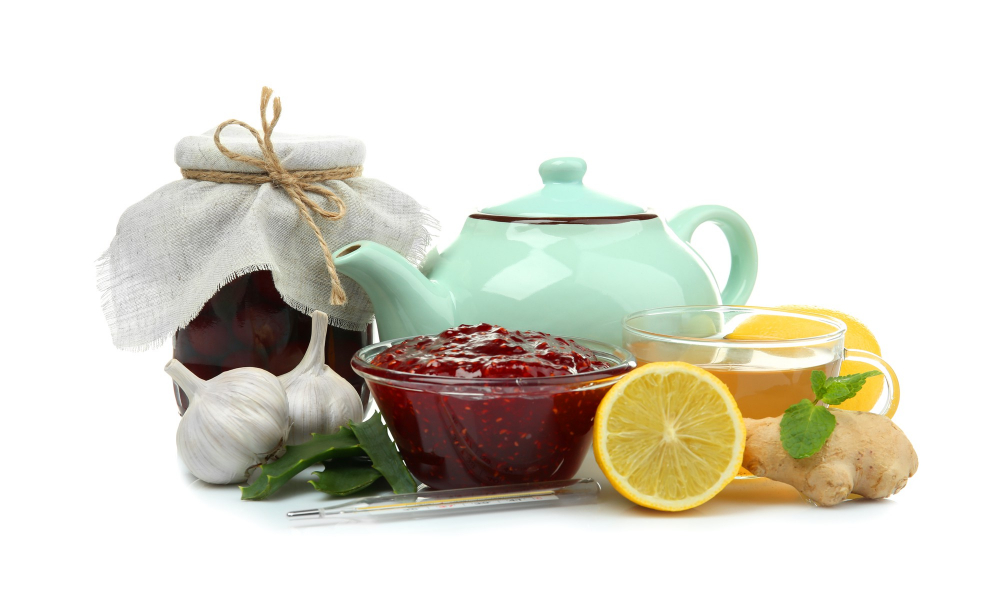
Best 10 home remedies for curing dry cough
Cough is usually treated as an infection of a disease but it is like a necessary evil. It sometimes helps in removing the foreign materials or irritants from your throat. But cough can also occur due to the presence of infection in the throat too. Coughing continuously for a long time can be annoying. So the cure of the cough purely depends on the reason for its presence in the first place. Cough can be caused due to allergies, infections, and other factors too.
Cough can be cured by many allopathic medicines. But using herbs and home remedies can also cure cough without any chemical or medicinal interference in your body. So following are the 10 home remedies that can cure dry cough right at your home.
1.Honey tea
Since traditional times it has been said that honey is known to have many medicinal values as well as therapeutic effects on skin and others. Curing cough is one of the main therapeutic uses of honey. There was a study performed to test the therapeutic effect of honey on children. Many children with nighttime coughing were treated with dark honey and others were treated with a medicine called dextromethorphan. It was found out that dark honey provided more relief to the children than the medicine called dextromethorphan. Although there weren’t a large number of benefits that honey had over dextromethorphan, still it was preferred by most parents over the medicine. To safely consume this to cure cough, two spoons of honey were added to warm water or any herbal tea and consumed at least two times a day. This would effectively cure your cough. But honey is not advised to give children below one year of age.

2.Ginger
When we have a dry cough apart from the unpleasant feeling of coughing there is a lot of pain and discomfort that is felt usually by coughing constantly. Ginger is known to have anti-inflammatory properties which may provide you relief from the pain and discomfort. This may also provide you ease while coughing. Moreover, it is found that the anti-inflammatory substances present in ginger are known to dilate the respiratory tract so that it would ease up the cough. Till now the effects of ginger have just been seen in animals and human beings so more research is needed to be done.
To consume it right, you can add approx. 30g of ginger in a hot water and let it steep for a few minutes before you consume it. For further taste and comfort to your cough, you can also add lemon or honey to it.
But in some cases, ginger tea is known to cause heart urn and many digestive problems.

3.Fluids
Keeping yourself hydrated at this time is one of the main things you have to keep in mind. According to many studies it has been proved that drinking fluids at room temperature can stimulate the running nose and cough and sneezing. It is always advisable to warm up your fluids before consumption. Warming up of fluids can provide relief to your throat as well as can reduce the symptoms too.
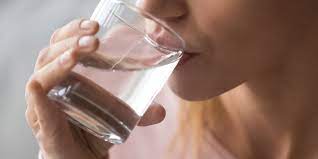
4.Steam
Taking the steam can help you to cure mostly wet coughs and mucus and phlegm but in case of dry cough, this has been found effective. You can take a shower in hot water and let the team fill up the bathroom and you can stay in it till your symptoms are reduced. Afterward drinking some cool water or any fluid is encouraged to prevent your body from dehydrating

5.Marshmallow root
This is a herb that is used to reduce the pain and discomfort caused by coughing. It does it because it has mucilage in it. Mucilage is a thick coating that the marshmallow root lays on the throat. It is a sticky and thick content. It protects the throat from wearing due to the cough. In a study, the effectiveness of this marshmallow root was proven. The people suffering from cough were given cough syrup which had marshmallow root and thyme and ivy in it. After 10-12 days 90% of those people felt relieved and they did not have a cough anymore.

6.Saltwater gargle
It helps in reducing the phlegm in the throat and it, in turn, lessens the urge to cough. Half a teaspoon of salt is added to hot water. And this water is used to gargle so that it reduces the phlegm.

7.Bromelain
It is an enzyme. This enzyme is mostly found in pineapples. Bromelain contains anti-inflammatory properties and is used to treat mucolytic. This nature helps in reducing the phlegm and breaking it down and removing it out of your body. This is an enzyme so it is possible to be allergic to it. It can also interfere with medication and have side effects. Mainly for people who take blood thinners should steer clear of bromelain.
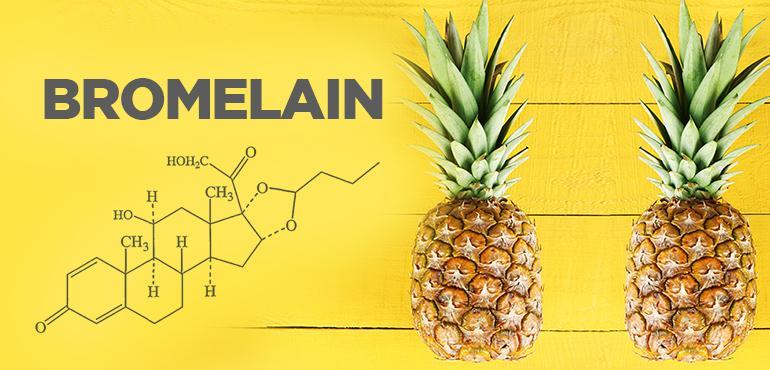
8.Probiotics
This does not directly act in preventing cold but it plays an important role in improving your immune system. If your immune system is strong your immunity will help in fighting all the allergens infections and all other causes of your cough. Out of all the probiotics, lactobacillus is one of the best probiotics that helps in preventing the common cold and cough, etc. Some medications are rich in this lactobacillus that is readily available in all drug stores but in the case of home remedies, you should consume dishes like kimchi, yogurt, miso soup, etc.
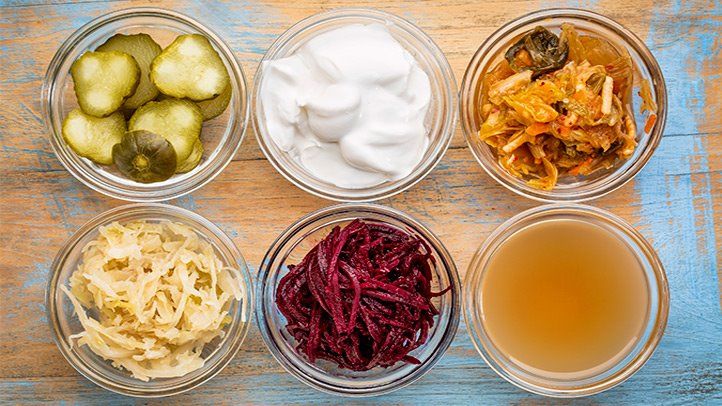
9.Dietary changes for acid reflux
Acid reflux is one of the main causes of cough. You can easily reduce cough by reducing acid reflux. You can reduce acid reflux by stopping the intake of this kind of food which stimulates acid reflux. These kinds of foods are alcohol, chocolates, caffeine, onion and garlic, fried and fatty food.
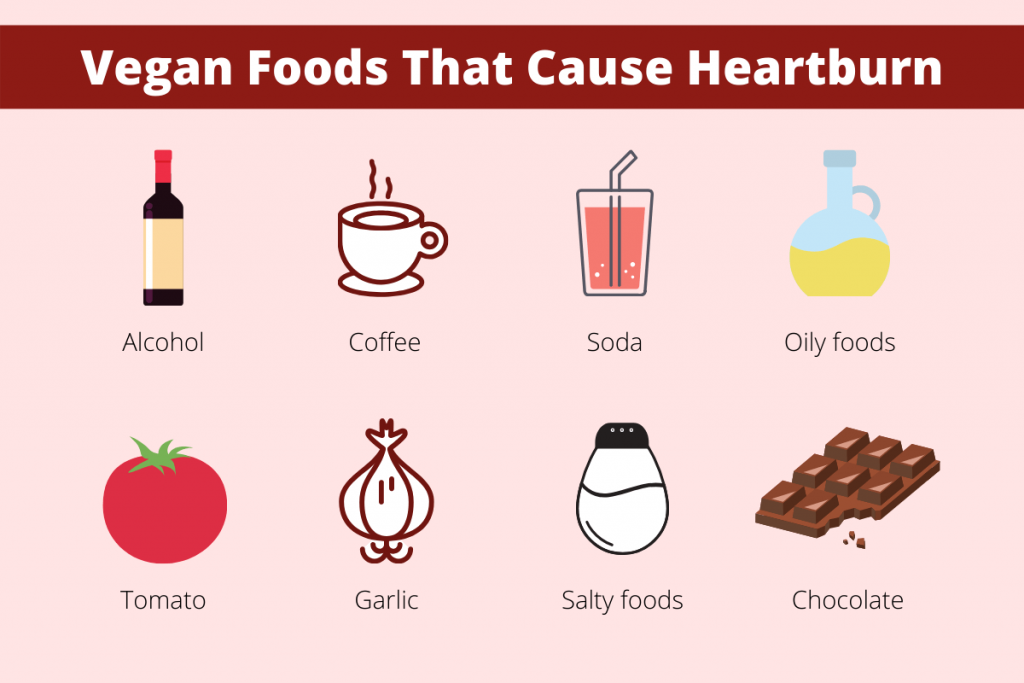
10.Slippery Elm
This is a traditional method of north America. The people there traditionally used to consume the bark of this slippery elm tree to cure dry cough and common cold.

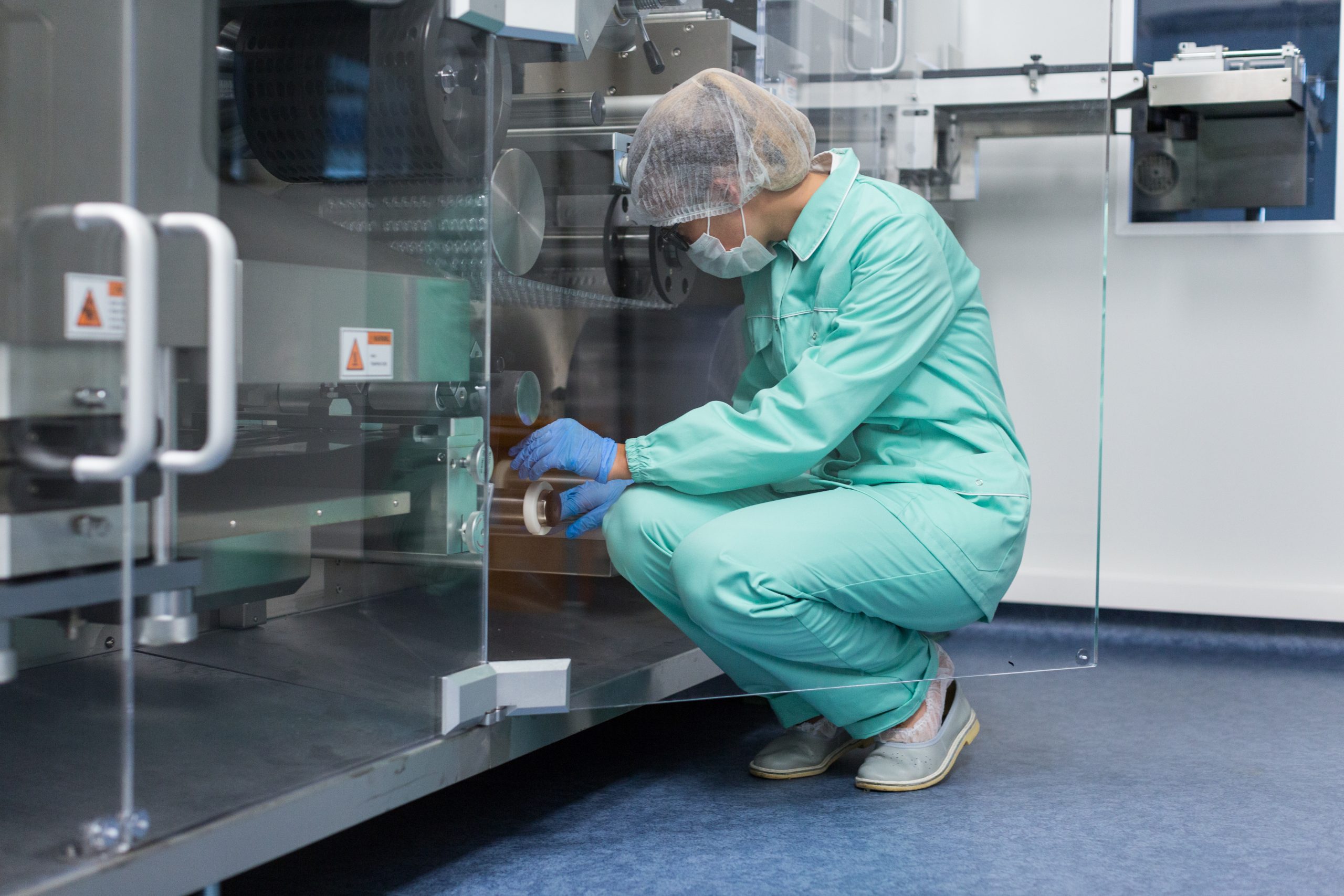
Titanium Is Key For The Medical Industry
Titanium alloys are used to manufacture medical equipment such as surgical, dental, and other instruments. The article’s accompanying materials go into further detail about the advantages of this metal in medicine.
A common dental material since the middle of the nineteenth century, titanium. It has evolved since the 1950s and is currently used in a wide range of surgical procedures and medicinal treatments, including but not limited to orthopedic and cardiovascular procedures.
Because of its bacterial resistance, durability, and light weight, titanium is one of the best materials for medical supplies, surgical equipment, and device parts. The metal is ideal for use in operational equipment, medical supplies, and import parts for machines like pacemakers and prosthetic joints because of its characteristics.
Because of it’s excellent medicinal characteristics and marketability, new medical applications are constantly being investigated and tested. The number of medical operations that currently or in the future use will increase as the US population becomes older. Therefore, these companies will have to spend a lot of money on R&D. The accompanying infographics provide more information about titanium’s benefits and medical uses.
Titanium In The Medical Industry from Titanium Processing Center

10 Most Common Skin Diseases & Skin Disorders
Skin is one of the most important parts of our body. They are the parts that get the most attention. We spend a fortune on maintaining our skin and preserving the glow in our skin. We need to know about the pathogens or the infections which may affect your skin. Because the infection and pathogens on our skin can not be corrected by skin products that are available online. Our skin is known as the largest organ in our body. It covers our muscles and nerves and protects them from injury or bacteria from the outside world. It extends from the tip of the skull to the tip of the toes. Skin diseases are known to be the most severe. They can be temporary, permanent, or they can be recurring.
Some are caused due to certain circumstances while most others are caused due to genetics. There are other skin infections caused due to trauma too. Most skin conditions are not a threat to life but other skin conditions are a threat to life. They can be chronic and lead to death. If you find any skin defects or any abnormalities in your skin, you should go to the doctor immediately. To be able to identify the skin conditions,
10 most common skin diseases are mentioned below.
1. Acne
These are small red elevations on your skin that lead to a bad appearance of your skin. It usually occurs in your face and it can occur in groups or a single big and redone. These are mostly found in the areas of the face, neck, shoulders, chest, upper back, etc. It occurs on the skins with blackheads, Whitehead, pus, pimples, or they can also appear as cysts in the deeper tissue. They do not leave scars but if the acne is irritated then it might leave a scar on your skin.
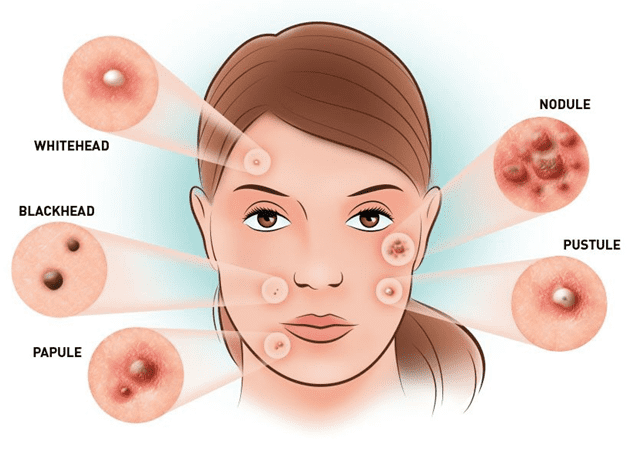
2. Cold sores
Cold sores are blister-like appearances that occur mostly on your face. The infections that occur on your face should be taken care of better than the infection in your upper body or the trunk. They occur mostly on your lips, the upper lips, and nose areas. You can know if you’re going to have it beforehand. The skin on which you will have it will tingle or you will feel a burning sensation before the scar is visible. These can also appear with flu-like features. Mostly the patient will have a low fever, headache, chill, swollen lymph nodes, and body aches.
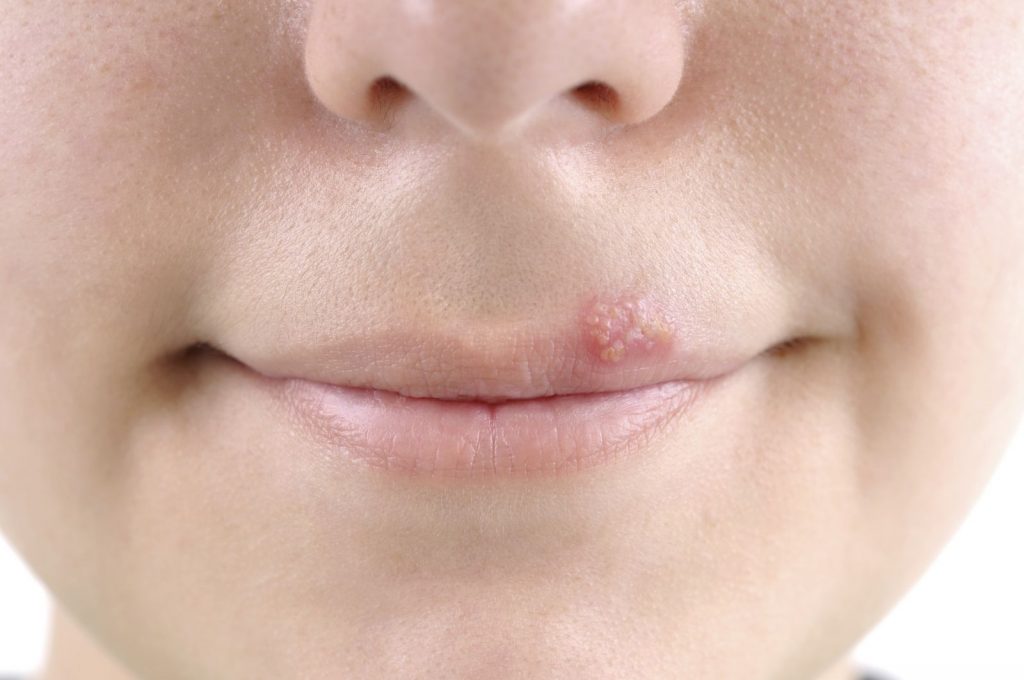
3. Blisters
This is a very common infection that occurs on the skin. It is very painful. Usually occurs due to trauma to the skin for a long time and it also causes a lot of pain and discomfort. It can be differentiated from other infections based on a clear, watery fluid-filled area on the skin. It is either smaller than 1 cm or it is larger than 1cm. The blisters which are smaller than one centimeter are called vesicles and the one’s larger area is known as bulla. They can occur in groups or they can occur singly. It can occur anywhere in our body and has no special preferences.
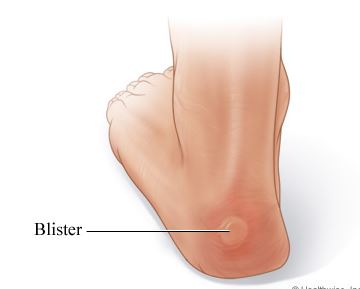
4. Hives
These are the patterns that are linked with allergy. It occurs only with the contact of an allergen. Mostly known as an allergy reaction of the skin when it comes in contact with an allergen. These are itchy raised patterns that mostly relish in color. So these are red warm to feel and painful when touched. Typically small round ring-shaped but at times they can be irregular and large.
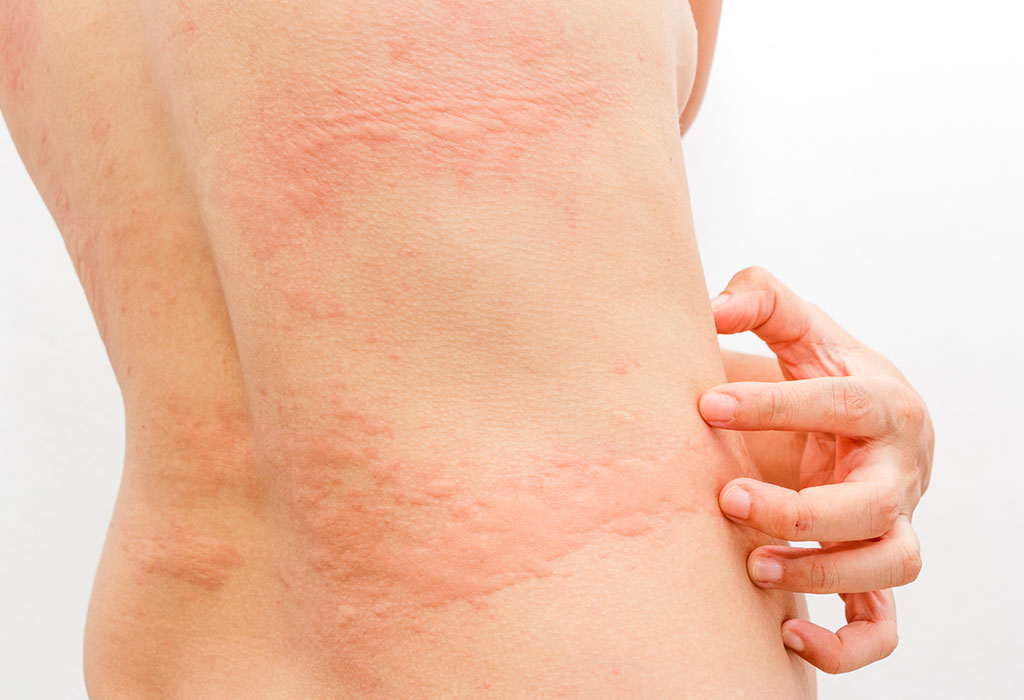
5. Actinic keratosis
It’s even less than 2 cm. They are sometimes the size of a pencil eraser. It has a thick scaly rough skin patch that has a crusty appearance. The site of occurrence in the body is that part that is mostly exposed to the sun. These are mostly hands, neck, face, arms, and scalp. These are usually pink in color. But it can have a gray-brown or tan base.
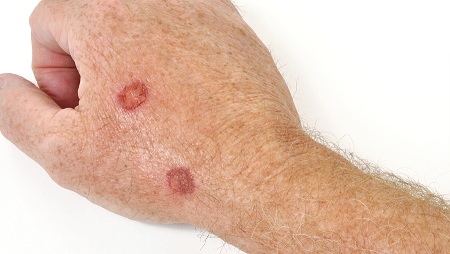
6. Rosacea
It is a chronic skin disease. Usually fades up and then reappears again. It cycles that way. The reappearing of this can depend on many physical conditions. Some of them are stress, alcohol consumption, intestinal bacteria like helicobacter pylori, or overexposure to sunlight. This disease has four different types of infection with a large variety of symptoms. The most common symptoms are facial redness, facial blushing, facial red bumps on the skin, skin dryness, skin sensitivity.
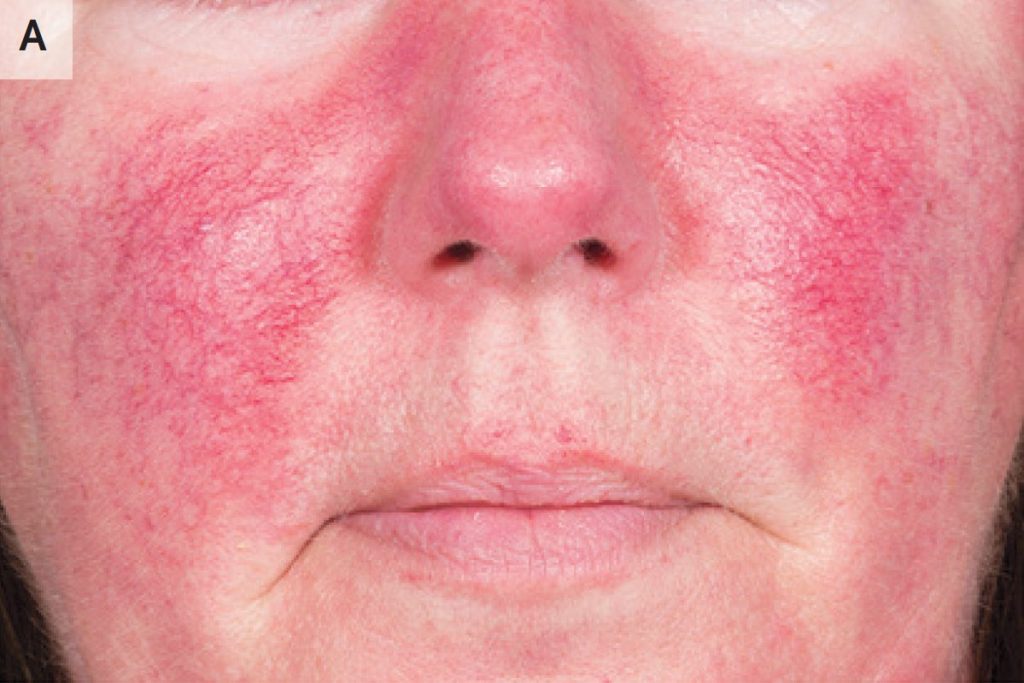
7. Carbuncle
It is a lump that is present under your skin, usually lor and sore to the touch, can feel irritated when it occurs. It may demonstrate many flu-like symptoms that are fever, chills, body aches, etc. So It can cause skin crustiness. It also causes ooziness.
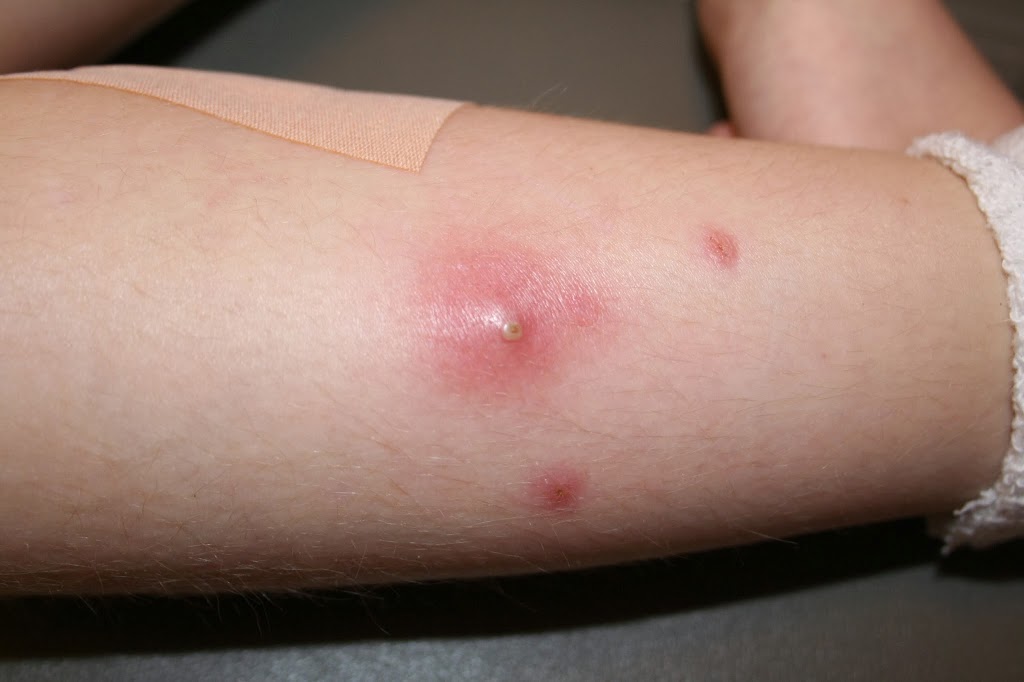
8. Latex allergy
It is another common skin condition caused by the use of latex mostly as a glove. It is a severe and emergency condition. Immediate doctor’s care should be needed If this happens. The rash can occur for minutes or can take days to appear. It appears when the skin is exposed to latex. It is characterized by the appearance of red spots and it may feel itchy. The site gets dry and feels crusty when the area is exposed to latex repeatedly. Apart from using If latex gloves, airborne latex can also cause cough, running nose, itchy, watery eyes, and many more symptoms. Severe allergy can cause swelling and difficulty in breathing. When it not cares well, it makes a skin diseases.
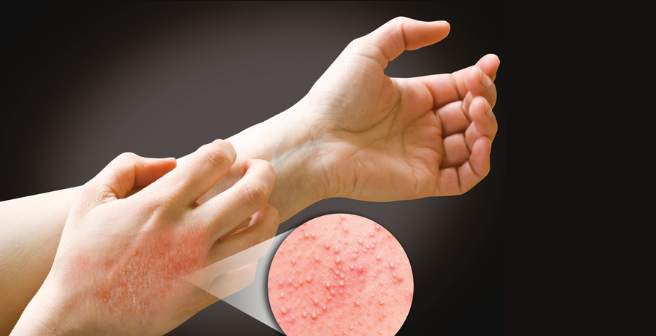
9. Eczema Skin Diseases
These are yellow and red patches that can have a flaky appearance. These are elevated areas and are sensitive to touch. Hair loss may occur in these areas. When it not treats well, it creates skin diseases.
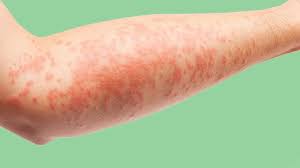
10. Vitiligo Skin Disease
It is a most common skin disorder in tropical countries. It occurs due to an autoimmune disorders. The body defense mechanism kills the cells of our own body. This gives skin its color.

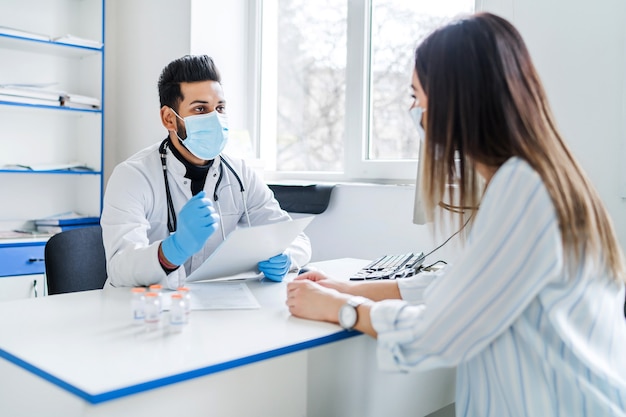
Hospital Monitoring Software Development: Secret Features And Also Perks
Over the last couple of years, the demand for convenient medical solutions has increased. In combination with the rapid digitalization of the sector, even more software application systems and tools appear in clinical establishments.
Software remedies are developed to automate everyday operations, manage bills and paperwork, as well as supply, and generally decrease the stress on medical professionals.
Among the most extensive all-in-one systems is the healthcare facility administration software system; in this write-up, we will explore SaaS-based HMS and its core benefits and attributes.
What is a Health Center Administration System?
A health centre monitoring system is an independent or cloud-based internet medical management facility that captures and incorporates all divisions’ information to automate the inner tasks.
At its core, HMS intends to simplify the process for clinicians, reduce management expenses, diminish errors, and supply a far better client experience. Nonetheless, it encompasses a wide array of functions, as the system takes care of every department or branch of the health centre.
It accumulates medical professionals, clients, laboratory outcomes, clinical products, appointments, costs and insurance, and records.
Benefits of Hospital Monitoring Software
1. Decreased prices and also work
The reliable distribution of resources is essential to great care as well as the overall well-being of the organization. A well-managed workload and effective budgeting, in particular, allow for optimum planning of healthcare facility performance.
Due to software programs with considerable scheduling capacities, subject-based alternatives can enhance doctor-patient communication. In addition, keeping an eye on scientific, personal, and financial information is feasible if all documents and transactions are maintained in the system.
2. Enhanced client experience
Raising hospital management software applications’ uniformity, scalability, and dependability improves client care and experience, making a health care method’s procedures significantly more effective.
Proper data management can prevent such healthcare issues as delayed taking care of people that require prompt medical focus. Therefore, healthcare facility monitoring software would undoubtedly enhance the performance and allure of healthcare solutions to their vital audience: physicians and people.
3. Improved operations
A system that can care for all types of clinical data, stock, results, and coverage can considerably increase a medical facility’s effectiveness. In addition, the software program filters information automatically, causing faster available treatments and removing time-consuming, recurring jobs that humans need to embark on.
Human mistakes are the 2nd most prominent source of medical care mismanagement, and the hospital monitoring system significantly decreases the possibility of this occurring. For example, there is much less probability of replication, document typos, or other mistakes with enhanced information administration.
What kinds of information does the health centre administration system process?
Aside from information types, hospital monitoring software has separate systems that care for various job markets. The primary system types consist of:
Functional and tactical systems
One of the most prevalent techniques for categorizing medical information is operational systems. Its assimilation enables you to send details hierarchically, with these systems managing different sorts of clinical understanding at each level.
Moreover, it enables reliable and quick information operation, along with detecting system abnormalities.
Administrative systems
This HMS module is required for all healthcare facilities and is responsible for providing personal details in the form of records and data.
When the client is released, as well as following medical assistance (to provide specifics), details are taken into the system and also sent as a report to the Division of Health and Wellness (DOH).
The scientific system, which consists of digital patient records (EPRs), is built on the management system because administrative details are attached to various scientific systems.
When producing such a system, remember that it carries out worse than options such as subject-based ones owing to the higher possibility of information duplication, which influences system performance, disk space optimization, and the nature of data selection storage space.
Invoicing systems
Payment systems supervise tracking and taking care of the hospital’s finances. The tagging of different results from medical care management systems with the associated prices allows for the surveillance of clients, setting you back.
Most of the set you back are done by analysing the previous year’s expenditure circulation. The ability to charge and control payment/non-payment is an essential attribute of such systems. Thus, billing systems are necessary for ideal financial efficiency in medical facilities.
Main features of Hospital Monitoring Software
Research laboratory monitoring
Among the HMS attributes are the capability to handle test results and person information and connect with other lab systems to enhance workflow efficiency and information precision and add worth to the general person therapy cycle.
Results administration can consist of monitoring, quality assurance, reporting, and various other activities. The HMS system incorporates research laboratory systems, collects needed information, and types it in the design, layering with added patient details if required.
Digital medical records (EMR) monitoring
EMR software program is a consolidated information hub that stores all vital personal info, such as health and wellness documents, goes to, vaccines, medications, doctor’s notes, and so forth.
Who added new and upgraded attributes and functions as health care remedies developed, but the core set stayed the same.
However, with the global pandemic and enhanced digitization of the health care sector, streamlined, incorporated, protected, and high-performing EHR and invoicing software programs will certainly be required.
Mobile application
The wellness technology sector is swiftly expanding, with a recognizable boost in patient-targeted applications and products. Because of this, medical care mobile apps are a crucial component of the health centre’s life process.
A well-integrated application may bridge the gap between the individual and modern technology, dramatically enhancing the consumer experience.
In a medical care setup, the advantages of straightforward and practical application design extend beyond the evidence and assist in quicker and extra efficient illness treatment.
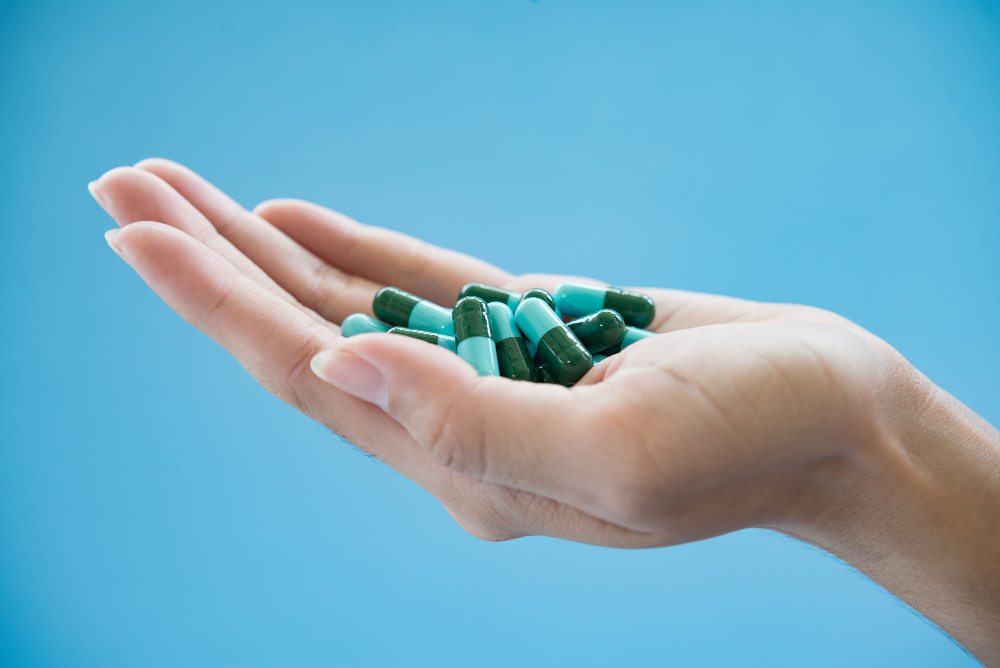
Throwing Out Your Old Medicine
What’s the best way to dispose of drugs when cleaning out your medicine cabinet? Unfortunately, improper disposal could result in water system contamination depending on the chemical makeup of the medicine. Human health and marine environments are just two of the many things this pollution has an impact on. Here, the problems brought on by improper medicine disposal are briefly covered along with some advice on how to prevent them.
It had previously been suggested to employ these disposal techniques to stop accidental opiate misuse in both adults and children. On the other hand, pharmaceutical chemicals were not meant to be removed from water when septic systems and water treatment facilities were first built. It has been shown that streams and drinking water around the nation contain chemicals connected to narcotics.
40% of the nation’s drinking water, which is purified by subterranean aquifers, contains pharmaceuticals. All of these compounds have been connected to various medications, such as steroid, antibiotic, antidepressant, and painkillers. Since landfill chemicals seep into surface water, throwing pharmaceuticals in the trash could be hazardous. What type of damage could these substances do to the environment? Studies have demonstrated that unused prescription drugs affect various species, including fish and frogs, in terms of their growth, reproduction, and behavior. Contaminated seafood causes harm to both humans and animals.
Additionally, these substances—along with the byproducts of their breakdown—end up in lakes and rivers after being handled in wastewater treatment plants. After being exposed to different biomes, they begin to alter in terms of bacteria and nutritional value. A location’s level of microbial contamination may have a big effect. We then irrigate the crops and livestock ranches that support our way of life using the same water.
Even if huge offenders like hospitals, nursing homes, and cattle farms cannot be stopped, people can still contribute. Read the entire package insert for the medication first. On a brochure or leaflet, it should be noted the EPA waste code and whether the medication is flammable, corrosive, poisonous, or reactive. A flush list is also available on the FDA website. Determine whether it is advisable to flush or discard a medicine using this information.
Any medications you’re unsure of, bring them to a public drug disposal location in your neighborhood or a drug disposal facility. When buying, the same prudence should be used. Since medications might expire and lose their efficacy, they shouldn’t be kept on hand.
